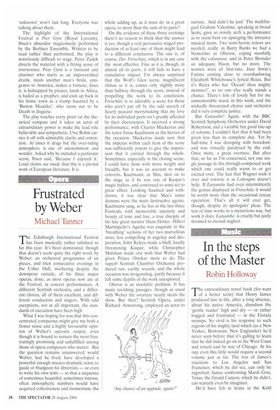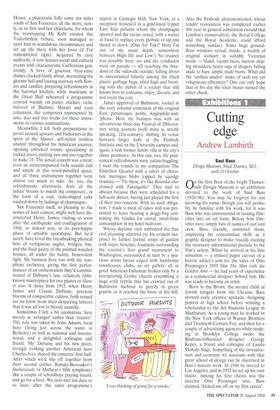In the steps of the Master
Robin Holloway
The extraordinary travel book (for want of a better term) that Henry James produced late in life, after a long absence, about his native America, abandons the 'gentle reader' high and dry — or rather bogged and frustrated — in the Florida swamps. So vivid is his response to such regions of his mighty land which (as a New Yorker, Bostonian, New Englander) he'd never seen before that it's galling to learn that he did indeed go on to the West Coast and return east by way of Chicago. At his rate even this little would require a second volume just as fat. The loss of James's reactions to Los Angeles and San Francisco, which he did see, can only be regretted; James confronting Mardi Gras, Texas, the Grand Canyon, which he didn't, can scarcely even be imagined.
He'd have felt at home in the Kohl House, a plutocratic folly some ten miles south of San Francisco: all the more, surely, as its first and last chatelaine, for whom the worshipping Mr Kohl created this Tudorbethan tribute, soon managed to eject him in scandalous circumstances and set up life there with her lover (if I've remembered right). Acquired by civic authority, it now houses social and cultural events with characteristic Californian generosity. A bevy of gracious, blue-rinse dames clucked busily about, decorating the gloomy hall and louring stairway with flowers and candles, preparing refreshments in the baronial kitchen; while musicians in the Great Hall rehearsed a programme centred warmly on piano, clarinet, viola, beloved of Brahms, Mozart and your columnist, the composers represented by solo, duo and trio works for these instruments in various combinations.
Meanwhile I left both preparations to prowl around upstairs and backstairs in the spirit of the Master, self-styled 'restless analyst' throughout his American journey, opening unlocked rooms, speculating at locked doors, putting two and two together to make 16. The actual concert was a treat: even an unaccompanied viola sounds rich and ample in this wood-panelled space, and all three instruments together were almost too much to take. As, too, the refreshments afterwards, fruit of the ladies' bounty to match the composers', in the form of a vast, viola-shaped cake washed down by lashings of champagne.
San Francisco itself, so pleasing to the senses of later corners, might well have disconcerted Henry James, visiting so soon after the earthquake and conflagration of 1906, or indeed now, in its post-hippie phase of amiable apocalypse. But he'd surely have loved the breathtaking physical brio of vertiginous angles, bridges, bay, and the fluid gaiety of the painted wooden houses, all under the balmy, benevolent light. My business here was with the symphony orchestra, giving the first performances of an orchestration they'd commissioned of Debussy's late, relatively littleknown masterpiece for two pianos en blanc et noir. It dates from 1915. when Henry James and Claude Debussy, precious blooms of comparable culture, both sensed (as we know from their despairing letters) that it was all lost in bloody anarchy.
Sometimes I felt a bit anomalous, here merely as 'arranger' rather than 'creator'. This role was taken by John Adams, local hero (living just across the water in Berkeley) as well as national and international, and a delightful colleague and friend. 'My' Debussy and his new piece, lovingly evoking another American hero Charles Ives, shared the concerts' first half. After which we'd slip off together from their second (either Rimsky-Boresakov's Sheherazade or Malheur's fifth symphony) like a couple of schoolboys playing truant, and go for a beer. We next met ten days or so later, after the same programme's
repeat in Carnegie Hall, New York, at a reception hostess'd in a gold-lined Upper East Side palazzo where the champagne spewed and the caviar oozed, with a waiter at hand to replace every globule or sip one dared to down. (One for Taki? Here I'm out of my usual depth, somewhere between High life and Low!) No truancy was possible here: we and the conductor were on parade — till reaching the freedom of the sidewalk outside, falling about in unrestrained hilarity among the black plastic garbage bags, piled high and bursting with the debris of a society that still knows how to consume, enjoy, discard, and not count the cost.
James approved of Baltimore, rooted in the early colonial settlement of the original East, picturesque, polite, Anglophile-and'phone. Here my business was with an adventurous three-day Festival of 20th-century string quartets (well, mine is, strictly speaking, 21st-century), shifting its venue between larger halls at the Peabody Institute and on the University campus and, again, a lush former family villa in the city's classy perimeter. At this one, too, the postconcert refreshments were palate-boggling. I went the rounds to my compatriots The Endellion Quartet with a salver of chocolate meringue blobs topped by squidg tiramisu — 'Try these, it's like Rosenkavelier crossed with Turangalila!' They had to abstain because they were scheduled for a full-scale dinner, having just played the first of their two concerts. With no such obligation, I made a meal of cakes and was permitted to leave bearing a doggy-bag containing the residue for carnal, small-hour consumption in my hotel bedroom.
Whose daytime view embraced the fine civil planning admired (to his evident surprise) by James: formal strips of garden with steps, benches, fountains surrounding the country's first grand monument to Washington, surrounded in turn by a spacious street layout edged with handsome townhouses, clubs, an art gallery; all in good American Italianate broken only by a horripilating Gothic church resembling a huge scaly reptile that has crawled out of Baltimore harbour to petrify in green granite as it reached the brow of the hill. Also the Peabody aforementioned, whose tender restoration was completed earlier this year to general admiration (would that London's conservatives, the Royal College and the Royal Academy, could afford something similar). Some huge groundfloor windows reveal, inside, a wealth of original statuary in suitably Victorian mode — bland, vacant faces, narrow sloping shoulders, heavy sags of drapery falling aside to bare ample nude bums. What did the 'restless analyst' make of such coy yet voluptuous effrontery? One can only hope that in his day the local muses turned the other cheek.



























































 Previous page
Previous page